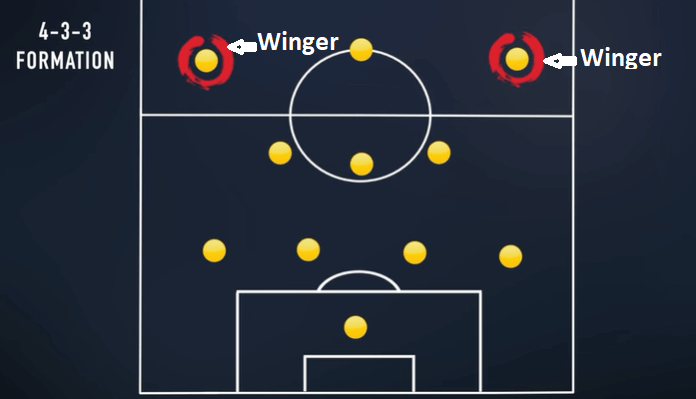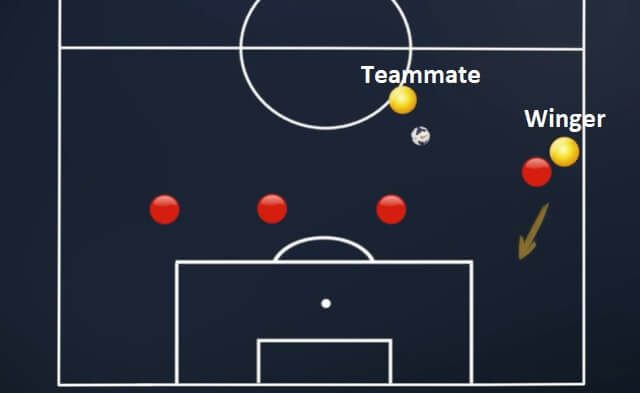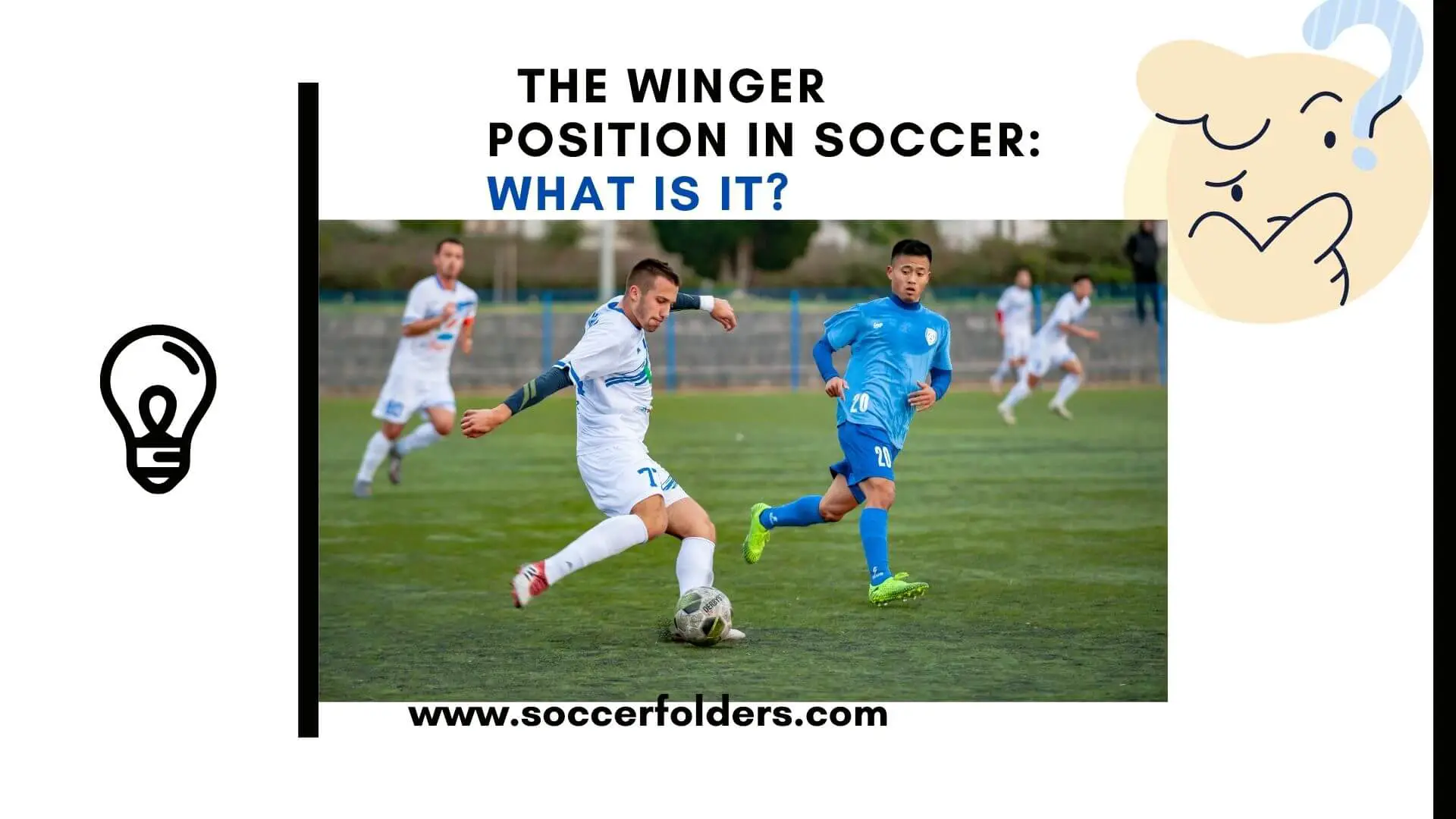The winger position in soccer is one of the hardest positions.
Soccer is a game that involves several positions. Each position requires specific skills and abilities.
Today, I’m going to talk about the wing position in soccer and everything you should know about it. This includes answers to the most frequently asked questions.
Let’s get started.
Quick Navigation
- The History of Wingers in Soccer
-
Winger Position In Soccer: FAQ
- 1. What Is A Winger In Soccer?
- 2. What Is The Role Of A Winger In Soccer?
- 3. How to Play Winger in Soccer?
- 4. Is A Winger A Forward Or Midfielder?
- 5. Is Wing a Good Position?
- 6. How Do You Position Yourself As A Winger In Soccer?
- 7. What Makes A Good Soccer Winger?
- 8. Do Wingers Play Defense?
- 9. What Wing Should I Play in Soccer?
- 10. How do Wingers Score More Goals?
- 11. How Can I Improve My Winger?
- The Different Types of Wingers in Soccer (e.g. Inside forwards, inverted wingers, traditional wingers)
- Importance of Wingers in a Team’s Tactics and Game Plan
- The Physical and Mental Characteristics of Soccer Wingers
- Winger Common Mistakes To Avoid
-
Winger Skills To Have
- Famous Soccer Wingers and Their Impact on the Game
- Wrap Up
The History of Wingers in Soccer
The history of wingers in soccer can be traced back to the early days of the sport when players were required to play in specific positions.
Wingers were initially seen as a supporting role, tasked with providing crosses into the penalty area for their team’s forwards to score.
Over time, the position evolved, and wingers became more attacking-focused, with the freedom to move inside the opposition’s box to score goals.
With the advent of new tactics and formations, the role of the winger became even more important, as teams began to rely on their pace, dribbling skills, and ability to stretch the opposition’s defense.
Today, wingers are considered key players in many soccer teams, and the position continues to evolve, with new tactical approaches emerging all the time.
Winger Position In Soccer: FAQ
1. What Is A Winger In Soccer?
A “winger” in soccer is a player whose position on the field is on the sides (left or right) of the midfield, known for their pace and dribbling skills, and tasked with providing crosses into the penalty area and attacking down the flanks.
2. What Is The Role Of A Winger In Soccer?
The role of a winger in soccer is to support the attack by getting down the flanks, either through dribbling or by making runs, and to deliver crosses into the penalty area for their team’s forwards to attack and score.
Wingers also help to balance the team and stretch the opposition’s defense, creating more space for other players in the middle of the field.
They also have the freedom to move inside the opposition’s box to score goals. Sometimes, it also depends on the formation of the team.
For instance, in a 4-3-3 soccer formation, a winger has fewer defensive responsibilities and is only required to attack.
In a 4-4-2 formation, the winger is often required to make some defensive efforts.
3. How to Play Winger in Soccer?
To play as a winger in soccer, you must possess several key skills and attributes. These include:
- Speed: Wingers need to be able to beat their opponents down the flanks and get to the byline to deliver crosses into the box.
- dribbling: Wingers must have good dribbling skills to take on defenders and create space for themselves and their team.
- Crossing: Wingers must have the ability to deliver accurate crosses into the box for their teammates to finish.
- Finishing: You should have a good understanding of where to be in the box and have the ability to finish opportunities yourself.
- Vision: You need to be able to read the game and make the right decisions in terms of when to cross when to take on a defender, and when to pass the ball.
- Endurance: Wingers often cover a lot of ground and must have the endurance to last the full 90 minutes of the game.
In terms of tactics, wingers should look to attack the opposition’s fullbacks and get crosses into the box as often as possible. When defending, you should drop back to help defend your team’s half of the field and protect the flank.
4. Is A Winger A Forward Or Midfielder?
The Winger position in soccer is typically considered a forward position, although it can sometimes be categorized as a midfielder depending on the team’s formation and tactics.
Some teams can play with a right and left midfielder, but they are not considered wingers. Wingers, instead, receive the ball and have to dribble the right or left back and create a goal-scoring opportunity.
Note that there can be some exceptions.
For example, if a team uses the 5-3-2 system, meaning 5 defenders, 3 midfielders, and 2 strikers. Two of these midfielders will use the width and also play as high as a winger.
This means they will support the strikers and often drop into the middle when their team has possession.
5. Is Wing a Good Position?
The winger position in soccer can be a good position, as it offers opportunities for attacking play and can have a significant impact on the outcome of a game.
However, it also requires a high level of athleticism and technical ability, as well as good tactical understanding.
Ultimately, whether the winger position is considered good or not will depend on the player’s skills, style of play, and preferences, as well as the coach’s tactical approach and the needs of the team.
6. How Do You Position Yourself As A Winger In Soccer?
As a winger in soccer, positioning is key to success on the field. Here are a few tips for positioning yourself as a winger:
- Stay Wide: A winger’s main role is to provide width to the team and stretch the opposition’s defense. Position yourself out wide to receive the ball and create space for others to run into.
- Stay High and Stay Low: When attacking, wingers should position themselves high up the field to receive through balls and crosses. When defending, drop back and defend the space behind the full-back.
- Be Alert to Opportunities: Wingers must be aware of their surroundings at all times and be ready to exploit any opportunities that may arise. This could include making runs behind the defense or receiving the ball in space.
- Support the Attack: Wingers must work closely with the forwards and midfielders to create chances and score goals. Make runs to receive the ball, play one-twos and cross the ball into the box.
By following these tips, you can position yourself effectively as a winger in soccer and make a valuable contribution to your team’s attack.

7. What Makes A Good Soccer Winger?
A good soccer winger typically possesses certain physical and mental attributes that are essential for success in their position. Physical characteristics include pace, agility, dribbling skills, and good crossing ability. Mentally, wingers need to be able to read the game, make quick decisions, and have good spatial awareness.
Additionally, good wingers are able to deliver accurate and effective crosses, have a good understanding of the game and their team’s tactics, and have the ability to score goals.
To be a successful winger in soccer, a player must have a combination of physical and mental attributes, along with a strong work ethic and the ability to perform consistently under pressure.
8. Do Wingers Play Defense?
Yes, wingers are expected to play both offense and defense in soccer. While they primarily focus on creating attacking opportunities and scoring goals, they are also responsible for tracking back and helping out the team’s defense.
A good winger must be able to balance their offensive and defensive responsibilities effectively in order to be successful.
9. What Wing Should I Play in Soccer?
Whether you should play as a left or right winger in soccer depends on several factors, including your dominant foot, your strengths as a player, and the tactical needs of your team. Ultimately, the best position for you is one that allows you to use your skills to the fullest and contribute effectively to the team’s success. It may be helpful to talk to your coach or an experienced player to get a better understanding of your strengths and how they fit into different positions on the field.
10. How do Wingers Score More Goals?
To score more goals as a winger in soccer, it’s important to focus on developing several key skills and attributes. Firstly, having good dribbling abilities and footwork can help you get past defenders and create scoring opportunities. Secondly, having strong shot accuracy and the ability to cross the ball effectively can also increase your chances of scoring. Additionally, having good movement off the ball, good positioning, and the ability to make intelligent runs can also help create scoring opportunities. Finally, developing a good understanding of your role in the team’s tactics and game plan can also help you be more effective in the final third and increase your chances of scoring.
11. How Can I Improve My Winger?
- Work on improving your pace. You need to have a very strong acceleration
- You have to be able to create something on your own. Try to always look for a 1v1 situation so you can set up a teammate or finish the attack yourself.
- Try to perfect your crosses. Having the ability to cross the ball will give you a great advantage.
- Go to the pitch and start training your crosses. Try to hit a specific area in the box and try to do it while running. This is going to give you the most realistic match situation possible.
- Get in shape. If your condition is top-of-the-line, it’s going to help you.
The Different Types of Wingers in Soccer (e.g. Inside forwards, inverted wingers, traditional wingers)
Wingers are a key position in soccer and play a vital role in a team’s attacking strategy.
There are three main types of wingers in soccer: inside forwards, inverted wingers, and traditional wingers.
Inside forwards tend to play more centrally and focus on creating scoring opportunities for themselves or their teammates through dribbling, passing, and vision.
Inverted wingers often play on the opposite side of their stronger foot and cut inside to shoot or make a through ball pass. Arjen Robben was the perfect example.
Traditional wingers play on the same side as their stronger foot and rely on speed, dribbling skills, and crossing ability to beat defenders and deliver accurate crosses into the box.
Each type of winger brings unique skills and abilities to the game, making it important for coaches to choose the right player for their team’s tactics and style of play.
Importance of Wingers in a Team’s Tactics and Game Plan

Wingers play a crucial role in a team’s tactics and game plan.
They are responsible for providing width to the attack, stretching the opposing team’s defense, and creating space for the centre forwards to operate in.
Wingers are also expected to contribute to the team’s offensive play by delivering crosses into the box, taking on defenders and creating scoring opportunities.
Wingers can be used to break down a stubborn defense or to add pace and dynamism to a team’s attacking play.
With their ability to impact the game in several ways, wingers are an important component of any successful team.
The Physical and Mental Characteristics of Soccer Wingers
Soccer wingers are known for their speed, agility, and dribbling skills.
They need to have a good first touch, be able to control the ball while running at pace and have the ability to cross the ball accurately into the box.
Wingers also need to have good vision and the ability to read the game to make the right decisions in possession.
Mentally, wingers need to have the confidence to take on defenders, and the ability to stay focused and composed in high-pressure situations.
They also need to be versatile, as they are often required to defend and help out their team defensively as well as contribute to their attacking play.
Overall, the combination of physical and mental attributes is what makes a successful winger in soccer.
==>>You can also read my full article about mental preparation for soccer.
Winger Common Mistakes To Avoid
Here are some common mistakes I often see with wingers:
- Some wingers are afraid to take responsibility. They are scared to dribble and lose the battle.
- Stop bringing the ball backwards. This is one of the most frequent mistakes with wingers. A winger is supposed to move forward no matter what.
- Making the wrong decision. Some wingers would shoot when they have to pass/cross and vice versa. Hence you have to know when to cross and when not to.
- Not waiting for the striker to be in the box. I often see wingers who, after getting rid of the defender, cross the ball without even seeing if the striker is in the box or not.
- Doing too much with the ball. When a winger has dribbled one or two defenders, he/she wants to do more and makes the striker wait too long.
These are the most common mistakes wingers make on the pitch.
Do you recognize yourself in any of them? I’m sure you do(Laugh).
Winger Skills To Have
Here are some skills to master as a winger:
1-Speed
Playing as a winger requires speed because you are going to spend the whole time running on one side from defence to attack-
Also, as a winger, speed is very important because you are going to receive through passes or long balls.
So, you need speed to make runs behind the defenders and give your teammate the perfect opportunity to pass you the ball through the channel.

2-Endurance/Stamina
Because of all the offensive and defensive efforts, a winger needs endurance.
A soccer game lasts for 90 minutes.
So, stamina is a must if you have to run the entire game.
3-Cross Ability
The primary purpose of a winger is to cross the ball for the strikers. If a winger player doesn’t have an excellent crossing ability, it will be pointless.
You have to master the art of crossing the ball.
Remember, practice makes perfect.
Train at least 3-5 days a week. You don’t need many people. You can do it alone or with a friend.
4-Vision
Having a vision on the pitch doesn’t apply only to midfielders, but this also applies to the winger.
A winger needs great vision to see his teammates positioning and pass them the ball when necessary.
Famous Soccer Wingers and Their Impact on the Game
I’m going to end this article with some of the best wingers in soccer.
Famous soccer wingers have had a significant impact on the game throughout history.
From the dribbling skills of George Best and the pace of Ryan Giggs to the creativity of Lionel Messi and the clinical finishing of Cristiano Ronaldo, wingers have played a crucial role in shaping the sport.
These players were often known for their ability to take on multiple defenders, create scoring opportunities, and provide width to their team’s attack.
With their unique skillset, they have helped their teams win numerous titles, both domestically and internationally.
Whether it is through their goals, assists, or overall contribution to the team, those wingers have left a lasting impression on the sport and continue to inspire future generations of players.
Wrap Up
The winger position requires speed, stamina, vision and great crossing ability.
If you have those skills, you are ready to play as a winger.
I hope you have gained value from this article.
Are you a winger? Do you like this position? Let us know in the comment section below.


The wing is a difficult position to play. As you say, it requires lots of stamina and speed. I used to play this position when I was younger, but these days when playing for fun prefer a less physically demanding position.
knowing when the best time to cross the ball to the box is critical in setting up for the best opportunities for scoring goals.
Awesome!
Hi, Andrew. I feel you. The older you become, the more it becomes difficult to play as a winger. For instance, Cr7 used to play as a winger, but today, his age doesn’t allow him to play in that position because it requires lots of speed and stamina.
Take care